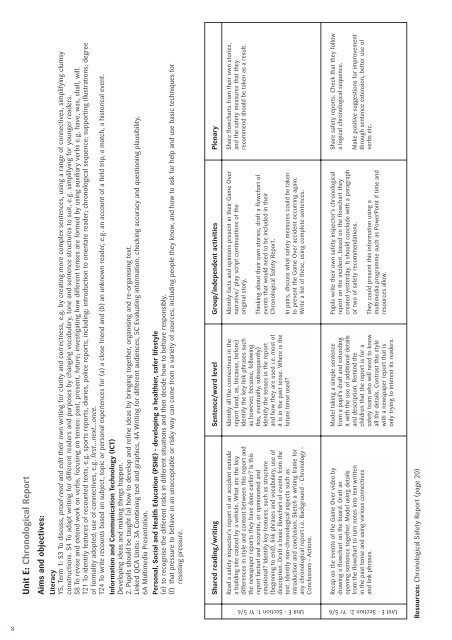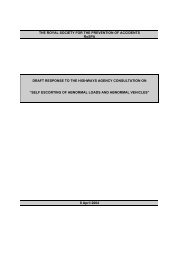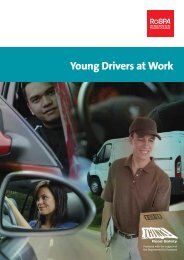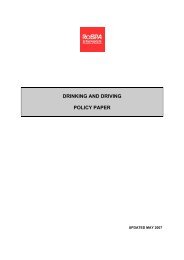SPLAAT : Safe Play At All Times - Key Stage 2 - RoSPA
SPLAAT : Safe Play At All Times - Key Stage 2 - RoSPA
SPLAAT : Safe Play At All Times - Key Stage 2 - RoSPA
You also want an ePaper? Increase the reach of your titles
YUMPU automatically turns print PDFs into web optimized ePapers that Google loves.
Unit E: Chronological Report<br />
Aims and objectives:<br />
Literacy<br />
Y5, Term 1: S3 To discuss, proof-read and edit their own writing for clarity and correctness, e.g. by creating more complex sentences, using a range of connectives, simplifying clumsy<br />
constructions. S4 To adapt writing for different readers and purposes by changing vocabulary, tone and sentence structures to suit, e.g. simplifying for younger readers.<br />
S8 To revise and extend work on verbs, focusing on tenses: past, present, future; investigating how different tenses are formed by using auxiliary verbs e.g. have, was, shall, will.<br />
T21 To identify features of recounted texts, e.g. sports reports, diaries, police reports, including: introduction to orientate reader; chronological sequence; supporting illustrations; degree<br />
of formality adopted; use of connectives, e.g. first...next...once.<br />
T24 To write recounts based on subject, topic or personal experiences for (a) a close friend and (b) an unknown reader, e.g. an account of a field trip, a match, a historical event.<br />
Information and Communication Technology (ICT)<br />
Developing ideas and making things happen.<br />
2. Pupils should be taught (a) how to develop and refine ideas by bringing together, organising and re-organising text.<br />
Linked QCA Units: 3A Combining text and graphics, 4A Writing for different audiences, 5C Evaluating information, checking accuracy and questioning plausibility,<br />
6A Multimedia Presentation.<br />
Personal, Social and Health Education (PSHE) – developing a healthier, safer lifestyle<br />
(e) to recognise the different risks in different situations and then decide how to behave responsibly.<br />
(f) that pressure to behave in an unacceptable or risky way can come from a variety of sources, including people they know, and how to ask for help and use basic techniques for<br />
resisting pressure.<br />
Shared reading/writing<br />
Sentence/word level<br />
Group/independent activities<br />
Plenary<br />
Read a safety inspector’s report of an accident outside<br />
a building site caused by a vehicle. What are the key<br />
differences in style and content between this report and<br />
the newspaper reports they have done earlier? Is this<br />
report factual and accurate, or opinionated and<br />
emotional? Identify key features, such as structure<br />
(beginning to end), link phrases and vocabulary, use of<br />
description. Draft a basic flowchart of events from the<br />
text. Identify non-chronological aspects such as<br />
introduction and conclusion. Sketch a writing frame for<br />
any chronological report i.e. Background – Chronology –<br />
Conclusions – Actions.<br />
Identify all the connectives in the<br />
report (and, as, because, before)<br />
Identify the key link phrases such<br />
as however, because, following<br />
this, eventually, subsequently)<br />
Identify the tenses in the report<br />
and how they are used i.e. most of<br />
it is in the past tense. Where is the<br />
future tense used?<br />
Identify facts and opinions present in their Game Over<br />
narrative/ play script continuations of the<br />
original story.<br />
Thinking about their own stories, draft a flowchart of<br />
events that would need to be included in their<br />
Chronological <strong>Safe</strong>ty Report.<br />
In pairs, discuss what safety measures could be taken<br />
to prevent the Game Over accident occurring again.<br />
Write a list of these, using complete sentences.<br />
Share flowcharts from their own stories,<br />
and the safety measures that they<br />
recommend should be taken as a result.<br />
Unit E – Section 1: Yr 5/6<br />
Recap on the events of the Game Over video by<br />
drawing a flowchart on the board. Draft an<br />
opening sentence together. Model using details<br />
from the flowchart to turn notes into text written<br />
in the past tense and using various connectives<br />
and link phrases.<br />
Model taking a simple sentence<br />
from a pupil’s draft and extending<br />
it with the use of additional details<br />
and description. Remind the<br />
children that the report is for a<br />
safety team who will need to know<br />
all the details. Contrast this style<br />
with a newspaper report that is<br />
only trying to interest its readers.<br />
Pupils write their own safety inspector’s chronological<br />
report on the incident, based on the flowchart they<br />
created yesterday. It should conclude with a paragraph<br />
or two of safety recommendations.<br />
They could present this information using a<br />
multimedia programme such as PowerPoint if time and<br />
resources allow.<br />
Share safety reports. Check that they follow<br />
a logical chronological sequence.<br />
Make positive suggestions for improvement<br />
through sentence extension, better use of<br />
verbs etc.<br />
Unit E – Section 2: Yr 5/6<br />
Resources: Chronological <strong>Safe</strong>ty Report (page 20)<br />
8

















